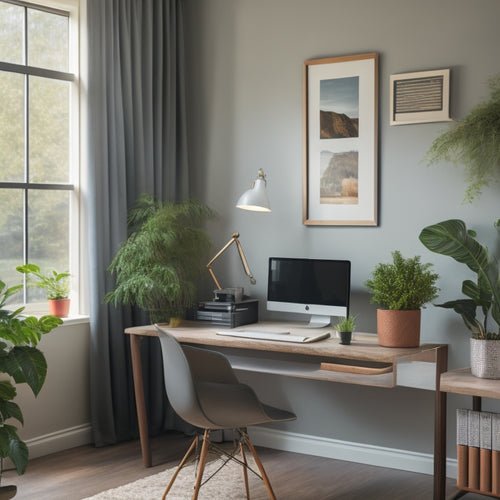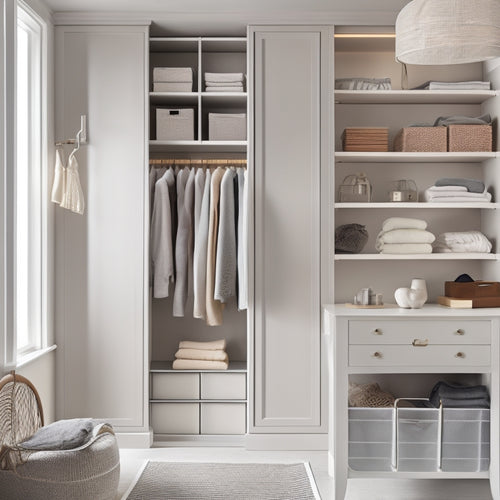
Optimize Your Small Home Office With Smart Storage
Share
You can instantly boost your productivity and reduce stress by optimizing your small home office with smart storage solutions. Start by maximizing your vertical space with shelves and cabinets that go up to the ceiling, and think creatively about storage solutions for overlooked areas. Allocate zones for work, reference, and personal items, and prioritize ergonomic accessories for your work zone. Consider multifunctional furniture like desks with built-in storage, and use storage solutions like collapsible file boxes and desk caddies to keep frequently used items within reach. By implementing these strategies, you'll be well on your way to a clutter-free workspace that sparks efficiency.
Key Takeaways
• Utilize vertical space with shelves and cabinets up to the ceiling to maximize storage potential in small home offices.
• Implement ergonomic accessories and allocate zones for work, reference, and personal items to optimize workspace efficiency.
• Choose functional furniture with built-in storage, such as desks and ottomans, to maintain a clutter-free environment.
• Optimize file organization with color coding, digital storage, and ergonomic storage tools for efficient document management.
• Select storage solutions products, like collapsible file boxes and shelf organizers, to enhance office organization and productivity.
Make the Most of Vertical Space
When designing a website or document, it's essential to make the most of vertical space to ensure that your content is easy to read and navigate. By strategically using headers, subheadings, bullet points, and white space, you can create a visually appealing layout that guides the reader through the information.
Headers and subheadings help break up the text and make it easier for the reader to scan the content quickly. Bullet points are useful for listing items in a concise and organized manner, while white space around text and images can help draw attention to key points and prevent the page from feeling cluttered.
Utilize Hidden Storage Areas
By incorporating shelves and cabinets that go up to the ceiling, you've already made the most of your small home office's vertical space. Now it's time to think creatively about utilizing hidden storage areas that are often overlooked.
To maximize your office's storage potential, consider the following hidden areas:
-
Under desk storage: Install a pedestal or a keyboard tray with built-in storage to keep office supplies, papers, or even a small laptop out of sight.
-
Overhead storage: Take advantage of the space above your desk or shelves by adding overhead storage units, such as baskets or bins, to store less frequently used items like archived documents or seasonal decorations.
-
Secret compartments: Incorporate creative shelving with hidden compartments or drawers to store valuable or sensitive items, like important documents, jewelry, or personal items.
Optimize Your Desk Real Estate
You'll be surprised how much more efficient your workday becomes when you strategically allocate every inch of your desk space. By optimizing your desk real estate, you can increase productivity, reduce distractions, and create a comfortable working environment.
Here's a breakdown of how to allocate your desk space effectively:
| Zone | Priority | Tips |
|---|---|---|
| Work Zone | High | Place your laptop or monitor directly in front of you, with ergonomic accessories like a keyboard tray and mouse pad. |
| Reference Zone | Medium | Designate a area for frequently used documents, notebooks, or papers, keeping them organized and within reach. |
| Personal Zone | Low | Add some plant decor to brighten up your space and purify the air, but keep them from obstructing your work flow. |
Don't forget about cable management! Keep cords organized using cable ties, clips, or a cable organizer to avoid clutter and tripping hazards. By allocating your desk space thoughtfully, you can create a functional and comfortable workspace that boosts your productivity. Make the most of your small home office by optimizing your desk real estate.
Choose Multifunctional Furniture
Two pieces of furniture that can be condensed into one can greatly impact the overall functionality of your small home office. By choosing multifunctional furniture, you'll create space saving solutions that maximize your office's potential. This approach allows you to maintain a clutter-free environment while still having all the necessary furniture options.
Here are three examples of multifunctional furniture that can benefit your small home office:
-
Desk with built-in storage:
A desk with built-in shelves, cabinets, or drawers provides ample space for storing office supplies, papers, and other essentials, keeping them out of sight while keeping your workspace organized. -
Ottoman with storage:
An ottoman with a storage compartment can serve as a comfortable seating option while storing items like files, binders, or office equipment. -
Wall-mounted shelf with a foldable desk:
A wall-mounted shelf with a foldable desk provides a compact workspace that can be easily set up or folded away when not in use, perfect for small spaces.
Create a File Organization System
Now that you've got your multifunctional furniture in place, it's time to create a file organization system that works for you.
You'll need to define your file categories, whether it's by project, client, or date, so you can easily locate what you need.
File Categories Defined
Define your file categories by identifying the types of documents you need to store, such as client contracts, tax returns, and marketing materials. This will help you create a tailored system that meets your specific needs. Consider the types of documents you handle regularly and group them into categories that make sense for your business.
Here are a few examples of file categories to get you started:
-
Client Files: contracts, invoices, and communication records
-
Financial Documents: tax returns, receipts, and bank statements
-
Marketing Materials: brochures, flyers, and social media content
Once you have your categories, you can start thinking about how to organize them. Consider going paperless and storing digital versions of your documents. You can also use color coding and alphabetical sorting to make it easy to find what you need.
File Retrieval Made Easy
With your file categories established, you can create a file organization system that allows you to quickly locate and retrieve specific documents when you need them. This is where a color-coded filing system comes in handy. Assign a specific color to each category, and use corresponding folders or labels to store your files. This visual system will help you quickly identify the category a file belongs to.
To take your file organization to the next level, consider incorporating digital organizing solutions. Scan and digitize your documents, and store them in cloud-based storage or on an external hard drive. This won't only free up physical storage space but also provide an additional layer of security and backup.
Ergonomic storage tools, such as file cabinets with easy-to-reach shelves, can also contribute to efficient document management. Label each shelf or drawer to match your color-coded system, ensuring that you can find what you need in seconds.
Incorporate Portable Storage Options
When you're working in a small home office, having portable storage options can be a game-changer.
You'll want to incorporate solutions like file crates on wheels, desk drawer organizers, or collapsible file boxes to keep your essential documents and office supplies within easy reach.
File Crate on Wheels
You can efficiently store and transport your office supplies and files with a file crate on wheels, a versatile and portable storage solution that keeps your workspace organized and clutter-free. This rolling storage solution is perfect for small home offices, as it provides mobile file organization and space-saving benefits.
Here are three ways a file crate on wheels can optimize your workspace:
-
Easy Access: Place frequently used files and supplies in the crate and roll it to wherever you need them, saving you time and effort.
-
Space Maximization: Store less frequently used items in the crate and roll it under your desk or against a wall, freeing up valuable floor space.
-
Flexibility: Use the crate to transport files and supplies between rooms or floors, making it an ideal solution for home offices with limited space.
Desk Drawer Organizers
Desk drawer organizers are customizable solutions that help you categorize and contain office supplies, freeing up valuable space and reducing clutter, while also allowing you to incorporate portable storage options that can be easily moved around your small home office.
You can create a tailored storage system using drawer dividers, desk caddies, and shelf organizers. These tools help you separate and store office essentials like paper, pens, and documents. For added convenience, consider wall pockets that can hold frequently used items, keeping them within easy reach.
Here's a sample layout to get you started:
| Section | Storage Solution | Benefits |
|---|---|---|
| Writing Utensils | Desk Caddy | Easy access to pens, pencils, and markers |
| Paper and Documents | Drawer Divider | Separates and organizes important files |
| Office Essentials | Shelf Organizer | Stores office supplies, freeing up desk space |
| Frequently Used Items | Wall Pocket | Quick access to frequently used items |
Collapsible File Boxes
Collapsible file boxes provide a convenient and versatile way to store and transport important documents. They allow you to easily move files between rooms or take them on the go. This portable organization solution is perfect for small home offices where space is limited. With collapsible file boxes, you can efficiently store and retrieve files without sacrificing valuable desk or shelf space.
Here are three benefits of using collapsible file boxes:
-
Easy transportation: Simply collapse the box, grab the handle, and take your files with you to meetings or presentations.
-
Space saving solutions: When not in use, the boxes can be easily stowed away, freeing up valuable space in your office.
-
Efficient filing: Collapsible file boxes often come with labeled tabs and compartments, making it easy to organize and find specific documents quickly.
Frequently Asked Questions
How Do I Keep Cords and Cables Organized in My Small Office?
You'll breathe a sigh of relief when you implement cable management and cord organization strategies, like using cable ties, cord concealers, and desk organizers, to keep your workspace tidy and clutter-free.
What Are Some Tips for Decluttering My Office on a Regular Basis?
You'll be drowning in a sea of clutter if you don't stay on top of it! Set aside 10 minutes daily to maintain your minimalist workspace design, digitize papers with digital storage solutions, and schedule weekly deep cleans to keep your office organized.
Can a Small Office Still Be Functional Without a Dedicated Desk?
You can still create a functional small office without a dedicated desk by incorporating standing workstations and multi-functional furniture, allowing you to work efficiently while maximizing space.
How Often Should I Update My File Organization System?
'Like a gardener pruning weeds, you should regularly tend to your file organization system, ideally every 3-6 months, to maintain its efficiency, incorporating paperless organization and digital backups, as well as a color-coded filing system with clear labeling techniques.'
Are There Any Eco-Friendly Storage Options Available for Small Offices?
You'll find eco-friendly storage options that fit your values, such as sustainable solutions like bamboo shelves and environmentally friendly recycled bins, which reduce waste and support a greener work environment.
Related Posts
-

Master Your Space With Digital Decluttering Tools
You're tired of feeling overwhelmed by digital clutter, wasting time searching for lost files, and struggling to focu...
-

Organize Your Digital Photos With These Online Courses
You've accumulated thousands of digital photos, and finding a specific one has become overwhelming. It's time to orga...
-

Mastering Small Closet Organization: Proven Strategies Unlocked
You're about to reveal the secret to transforming your small closet into a functional haven, where every item has its...


